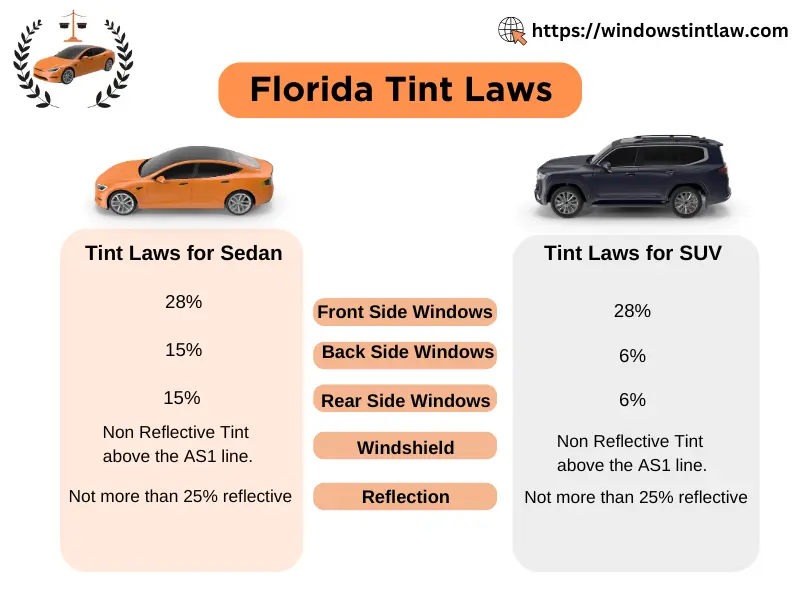Florida Tint Laws were implemented in 1991 by the State, to ensure compliance for installing legal tint on the vehicle windows registered in Florida.
In Florida, you can’t go beyond the allowed tint limits otherwise you may face penalties or legal actions by the state departments.
Tinting laws were regulated for safety and security of vehicles and occupants, we have mentioned complete details about Window tinting laws. Moreover, it is recommended to read the window tinting laws for Florida if you are planning to install tinted or sunscreen materials.
Overview of Florida Tint Laws
The below image illustrates the Tint regulations for Cars and SUV or Trucks registered in Florida. The below percentages are Visible light Transmission percentage, which means the amount of light that must pass through vehicle windows. The darkness of window tint is directly impacted by the VLT % , lower the VLT darker will be the tint. However, some tint types remain less darker even if they pass less percentage of light.
All vehicle owners and drivers must obey these Limitations, otherwise if caught with illegal tint, penalties and legal actions shall be taken by authorities.

Darkest Legal Tint in Florida
The darkest legal tint percentage for Sedan and SUV’s in Florida are mentioned as below:
Legal Tint Darkness For Sedan or Cars
| State | Front Side Windows | Back Side Windows | Rear Window | Windshield | Tint Reflection | Other Rules |
| Florida | 28% | 15% | 15% | Non reflective tint above the AS1 line. | Not more than 25% reflective | Dual Side Mirrors are required for rear tinted window. |
Legal Tint Darkness For SUV, Vans or Trucks
| State | Front Side Windows | Back Side Windows | Rear Window | Windshield | Tint Reflection | Other Rules |
| Florida | 28% | 6% | 6% | Non reflective tint above the AS-1 line. | Not more than 25% reflective | Dual Side Mirrors are required for rear tinted window. |
Window Tint Reflection in Florida
Reflective window tint produces glare from sunlight and headlights of other vehicle which may cause discomfort for other drivers. Due to this reason Florida Tint laws allow a certain percentage of Reflection from tinted materials. Tint Reflection limits for Cars and SUV or multipurpose vehicles are mentioned as below:
Windows Tint Reflection Limit for Sedan
- Front Side Windows: Front side windows must not be reflective more than 25%.
- Back Side Windows: Back Side Windows must not be reflective more than 35%.
Windows Tint Reflection Limit for SUV and Trucks
- Front Side Windows: Front side windows must not be reflective more than 25%.
- Back Side Windows: Back Side Windows must not be reflective more than 35%.
Other Rules and Regulations
In addition to Window Tint Darkness and Tint Reflection limits, Florida regulates some other rules which are given below:
- Side Mirrors: Dual Side Mirrors are required if the rear window is tinted.
- Sticker: Each installer or seller of sun screening material shall provide a pressure-sensitive, self-destructive, nonremovable, vinyl-type sticker and shall fix it inside the left door jamb of motor vehicle. .
- Certificate: Window film manufacturers don’t need to get certificate of the tint materials, for selling in the state.
- Tint Colors: According to Florida Tint Rules, Colored Tints are restricted.
Medical Exemptions
According to Florida Statutes Title XXIII. Motor Vehicles § 316.29545. medical exemptions or sun screening exclusion certificate shall be issued to person who is effected with Lupus, Autoimmune disease or any other medical condition which requires a limited exposure to light. The person with a medical exemption certificate can apply lower tints on his vehicle.
The medical exemption certificate shall be non-transferable and will become null or avoid upon the sale and transfer of the vehicle.
Penalties for Violating Tinting Laws
The penalty for non-compliance with Tint Laws is considered a non-moving infraction and is typically minor fine on the first time with a notice to remove the illegal tinting. However the fine increases with subsequent violations and you may get pulled over by the police for the continuous violations.
